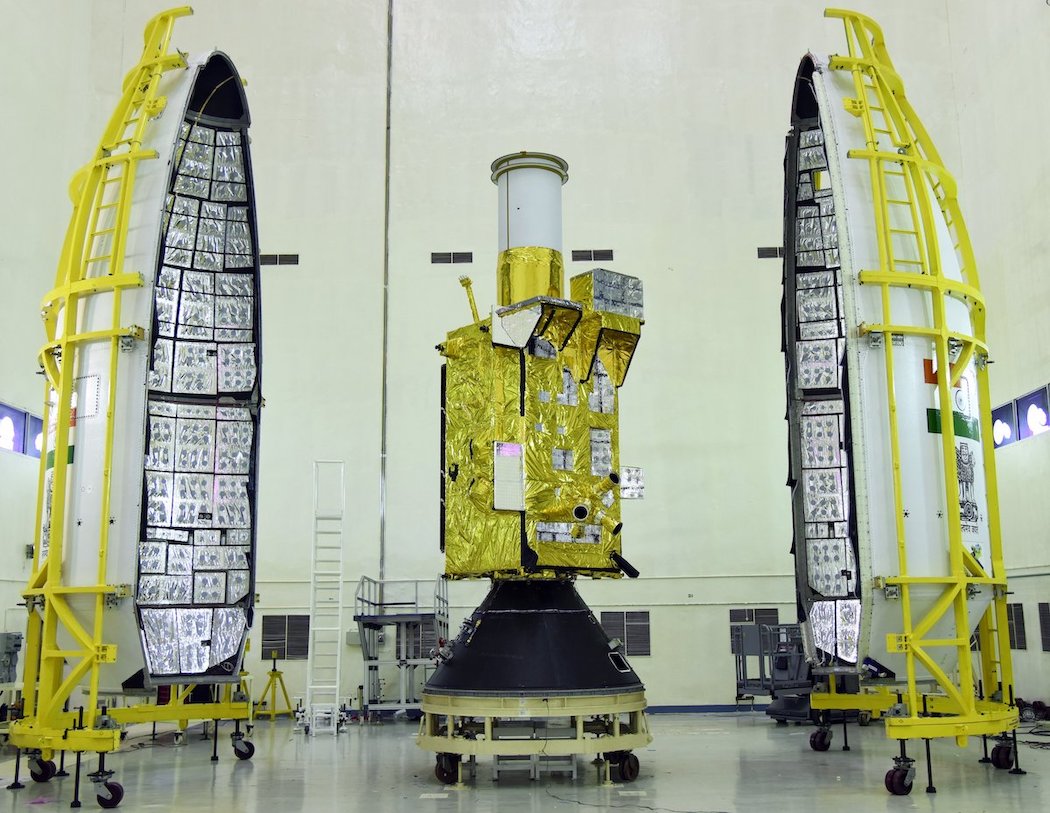
India is set to launch the first in a new line of high-altitude Earth observation satellites Wednesday aboard a Geosynchronous Satellite Launch Vehicle debuting a slightly wider payload shroud to accommodate larger spacecraft.
The GSLV Mk.2 launcher is set for liftoff at 8:13 p.m. EDT Wednesday (0013 GMT Thursday) from the Satish Dhawan Space Center on Sriharikota Island, located about 50 miles (80 kilometers) north of Chennai.
Liftoff is scheduled for 5:43 a.m. local time in India.
It will be just the second orbital launch of the year from India after the Indian space program ran into delays caused by the coronavirus pandemic.
The satellite fastened on top of the rocket, named EOS-03, is fitted with a large telescope to look down on the Indian subcontinent from a geostationary orbit more than 22,000 miles (nearly 36,000 kilometers) over the equator.
The roughly 5,000-pound (2,268-kilogram) spacecraft was formerly named GISAT 1. The Indian Space Research Organization renamed the craft EOS-03 under a new naming scheme for the country’s Earth observation satellites.
The satellite’s Earth-viewing telescope will take pictures of the entire Indian subcontinent at half-hour intervals, with the ability to image smaller regions as often as every five minutes. The satellite’s camera will be able to resolve features as small as 138 feet (42 meters) in its highest resolution mode.
EOS-03’s imaging system will take pictures in visible, near infrared, and shortwave infrared bandwidths, providing insights into the growth and health of crops and forests, changes in bodies of water, snow and ice cover, mineralogy, and the evolution of clouds, storms, and cyclones.
But the satellite’s primary purpose will be to serve as a quick-response tool providing near real-time monitoring of natural disasters and other short-term “episodic events,” according to ISRO.
EOS-03 is the first in a series of Indian geostationary Earth-imaging satellites.
The mission was supposed to launch on March 5, 2020, but ISRO announced the day before liftoff that the launch was postponed due to “technical reasons.”
Once engineers resolved the unspecified technical concerns, impacts from the coronavirus pandemic were forcing significant delays in India’s launch schedule.
India launched just two orbital missions in 2020 after launching six times in 2019. The launch of the EOS-03 satellite will be India’s second of this year, following a successful flight off the smaller Polar Satellite Launch Vehicle in February.

The GSLV Mk.2 rocket set to carry the EOS-03 satellite into orbit will be the first launcher to use a new larger payload fairing. The ogive-shaped fairing, which has a more curved shape than previous GSLV payload fairings, measures about 13 feet (4 meters) in diameter.
That’s about 2 feet, or 60 centimeters, wider than the older fairing design. The wider fairing is required to launch a joint NASA-ISRO radar imaging satellite on a GSLV Mk.2 next year.
At the culmination of Wednesday’s countdown, the GSLV Mk.2 will fire its hydrazine-fueled boosters at T-minus 4.8 seconds, run the strap-on Vikas engines through a health check, then command the solid-fueled core stage to ignite and propel the rocket off the launch pad.
Flying on nearly 1.8 million pounds of thrust, the GSLV Mk.2 will turn east from the Indian coast and climb into space over the Bay of Bengal. Its four boosters and core stage will shut down and drop into the sea around two-and-a-half minutes into the mission. The second stage’s Vikas engine will take over and burn for around 2 minutes, 21 seconds, producing around 190,000 pounds of thrust.
The GSLV Mk.2’s payload shroud will jettison during the second stage engine firing, revealing the EOS-03 communications satellite once the rocket ascends into space.
The third stage’s hydrogen-fueled engine will ignite at T+plus 4 minutes, 56 seconds, at an altitude of about 82 miles (133 kilometers). The cryogenic engine will do the rest of the work accelerating EOS-03 into its planned orbit, and shutdown of the third stage is expected at T+plus 18 minutes, 24 seconds.
The EOS-03 spacecraft will separate from the GSLV Mk.2’s third stage at T+plus 18 minutes, 39 seconds.
The GSLV Mk.2 will deploy the EOS-03 satellite in an elliptical geostationary transfer orbit. EOS-03’s on-board engine will maneuver the satellite into a circular geostationary orbit more than 22,000 miles (nearly 36,000 kilometers) over the equator, where will begin its 10-year service life at 85.5 degrees east longitude.
Email the author.
Follow Stephen Clark on Twitter: @StephenClark1.
